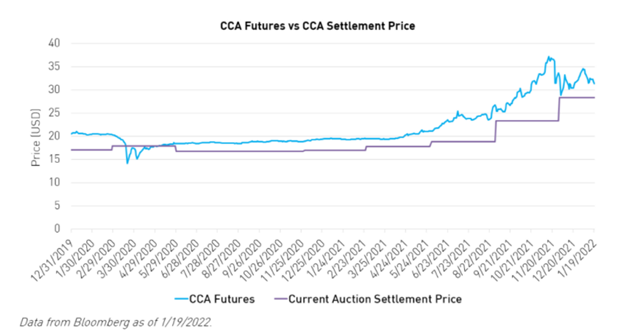Carbon allowance markets are booming, with 2021 seeing a record year of trading within markets; the Intercontinental Exchange (ICE) saw a 30% increase in carbon allowance trades worldwide last year, a total of 18.3 billion tons of carbon allowances, reports Reuters. Of that, California had a record 2.4 billion carbon allowances trade from its market, an increase from 1.87 billion in 2020, and the number is only expected to continue growing as pressure ramps up around emissions.
Prices for California Carbon Allowances (CCA) rose at a steady rate for most of 2021. Prices were driven increasingly higher by compliance entities engaging in risk management and therefore creating an upward price discovery trend, according to Luke Oliver, head of strategy at KraneShares, in a recent white paper.
KraneShares views the CCA as a market that is of particular interest because of the engagement in 2021 as well as the potential for tightening of the overall program this year, which could drive prices higher. However, Oliver cautions that volatility is expected in the market, particularly after the auction that happened at the end of 2021.

Image source: KraneShares
“Leading up to the auction, compliance entities and speculators had built physical and futures positions to the extent that fewer than anticipated joined the Q4 auction,” Oliver writes. “The absence of speculators meant a clearing price of $28.26 versus a futures price of $36, albeit the compliance entities participated with higher than normal demand.”
The market ultimately ended up correcting 12% based on the auction news, as well as the margin calls that had been taken on leveraged positions, causing some of the most aggressive speculators to wash out, Oliver explains. He hopes that this year will see an increase in the number of auctions that will help bring down volatility within the market; “there is no need for unnecessary event risk in such a critical market,” Oliver writes.
Content continues below advertisement
Investing in the California Carbon Allowances Market With KCCA
Last year, KraneShares expanded carbon allowance investing to offer more targeted investment approaches, including into the California and Quebec market with the KraneShares California Carbon Allowance ETF (KCCA).
KCCA is a fund that offers exposure to the California cap-and-trade carbon allowance program, one of the fastest-growing carbon allowance programs worldwide, and is benchmarked to the IHS Markit Carbon CCA Index. The CCA includes up to 15% of the cap-and-trade credits from Quebec’s market.
The index measures a portfolio of futures contracts on carbon credits issued by the CCA and only includes futures with a maturity in December in the next year or two, while using a wholly-owned subsidiary in the Cayman Islands to prevent investors from needing a K-1 for tax purposes.
The fund may also invest in emission allowances issued under another cap-and-trade system, futures contracts that aren’t carbon credit futures, options on futures contracts, swap contracts and other investment companies, and notes that aren’t necessarily exchange-traded.
KCCA carries an expense ratio of 0.79%.
For more news, information, and strategy, visit the Climate Insights Channel.

